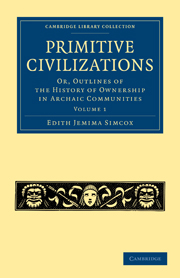Book contents
- Frontmatter
- PREFACE
- Contents
- CHAPTER 1 INTRODUCTION
- CHAPTER II PREHISTORIC PROBLEMS
- BOOK I OWNERSHIP IN EGYPT
- BOOK II ANCIENT BABYLONIA
- CHAPTER I SUMERIAN CIVILIZATION
- CHAPTER II BABYLONIAN CHRONOLOGY
- CHAPTER III THE ANCIENT CITIES OF SUMER AND AKKAD
- CHAPTER IV BABYLONIA AND ASSYRIA
- CHAPTER V COMMERCIAL LAW AND CONTRACT TABLETS
- CHAPTER VII DOMESTIC RELATIONS AND FAMILY LAW
- BOOK III FROM MASSALIA TO MALABAR
CHAPTER IV - BABYLONIA AND ASSYRIA
Published online by Cambridge University Press: 07 September 2011
- Frontmatter
- PREFACE
- Contents
- CHAPTER 1 INTRODUCTION
- CHAPTER II PREHISTORIC PROBLEMS
- BOOK I OWNERSHIP IN EGYPT
- BOOK II ANCIENT BABYLONIA
- CHAPTER I SUMERIAN CIVILIZATION
- CHAPTER II BABYLONIAN CHRONOLOGY
- CHAPTER III THE ANCIENT CITIES OF SUMER AND AKKAD
- CHAPTER IV BABYLONIA AND ASSYRIA
- CHAPTER V COMMERCIAL LAW AND CONTRACT TABLETS
- CHAPTER VII DOMESTIC RELATIONS AND FAMILY LAW
- BOOK III FROM MASSALIA TO MALABAR
Summary
FIRST AND SECOND BABYLONIAN DYNASTIES.
It is with the reign of Hammurabi that the importance of Babylonia—the country owning Babel as its capital—begins. Zabu, the third king of the first historical dynasty of Babel, is known to have built or restored temples in Sippara and Agade, because the incomparable Nabonidus records that Sagasaltias (1246—1233 b.c.) had to rebuild them. An early inscription, of which a much damaged copy was found in the library of Senacherib, might belong to the fourth king, the grandfather of Hammurabi. It seems to describe the gifts dedicated to the gods, by whose favour the king hopes to rule his people in peace, and it imprecates curses against those who deface the record. The same king was probably also the founder of a city on the borders of Elam, which bore his name. But this is all that is known at present of the first five reigns extending over somewhat more than a century.
Hammurabi (circ. 2250 b.c.) is the sixth on the Babylonian list. The great majority of the inscriptions of his long reign of fifty-five years, refer to peaceful works. A bi-lingual inscription upon a statue, translated by Hommel and Amiaud, however, describes him as “the mighty hero, the destroyer of the foe, the torrent of battle, the overthrower of hostile nations, he who silences the fight, and carries off the warriors, like statues of clay, as booty.”
- Type
- Chapter
- Information
- Primitive CivilizationsOr, Outlines of the History of Ownership in Archaic Communities, pp. 282 - 319Publisher: Cambridge University PressPrint publication year: 2010First published in: 1894

